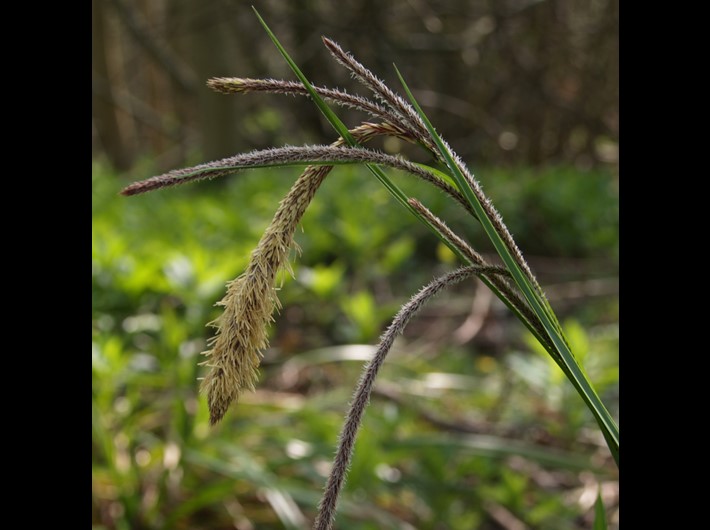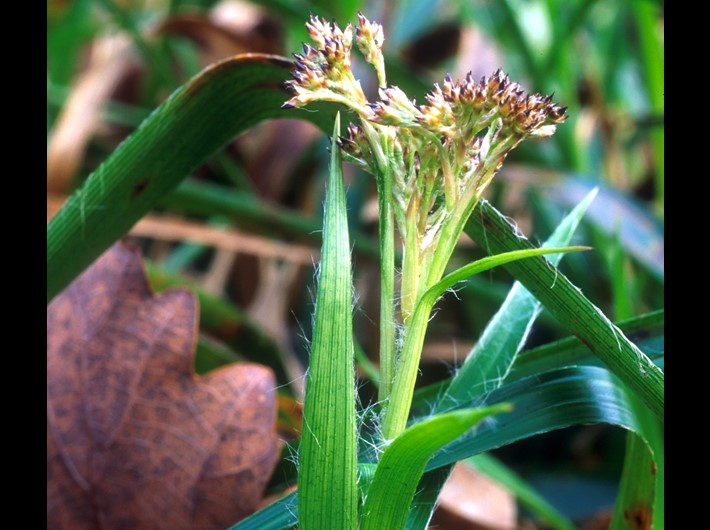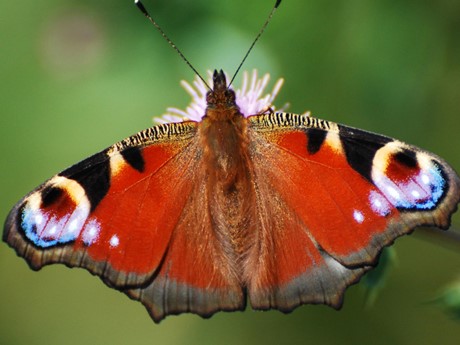How to identify common UK grasses
Judith Garforth and Martha Boalch, 14/05/2021
When identifying grasses it is important to distinguish them from sedges and rushes. The three plant types are in different botanical families, but because of their similar appearance they are collectively known as graminoids (plants with a grass-like appearance). They are all mostly wind pollinated so have very light pollen and small or no petals because they do not need to attract insects for pollination.
The difference between sedges, rushes and grasses

Pendulous sedge (Credit: Fran Hitchinson/WTML)

Greater wood-rush (Credit: Archie Miles/WTML)

Crested dog's-tail grass (Credit: John Bridges/WTML)
Sedges, rushes and grasses are actually quite easy to tell apart when you know how! An old rhyme can help you remember the main differences:
"Sedges have edges, rushes are round, grasses are hollow, so what have you found?"
- Sedges form the Cyperaceae family. They have solid stems, normally with 3 defined edges in a triangular shape. Their leaves grown in three 'ranks' (this means that leaves grow on each of the three sides of the stem in vertical rows). The fruit is called an achene (a one seeded fruit that does not open to release the seed).
- Rushes form the Juncaceae family. They have solid stems that are generally round. Their leaves tend to be clustered at the base rather than growing up the stem. The fruit is a many seeded capsule.
- Grasses form the Poaceae family. Their stems are usually hollow (except at the nodes) and cylindrical. They have alternate leaves in two ranks (two vertical rows). The fruit is a one seeded grain.
How to identify four common grass species:
There are about 12,000 grass species worldwide ranging from wheat to bamboo. Some grasses have important economic roles to play. The four grasses described below are common, widespread in the UK and can all be recorded for the Nature's Calendar project.
Meadow foxtail (Alopecurus pratensis)
Meadow foxtail grows in dense tufts and its fluffy, cylindrical flower-head is one of the easiest ways to identify this grass.

Meadow foxtail grass (Credit: Hugh McKean/Alamy)

Meadow foxtail in flower (Credit: Margaret Barton/WTML)
- The leaves are hairless.
- The flower-head is a long cylindrical shape (2-13cm long and 5-10mm wide) with a blunt end. It looks furry (like a fox's tail).
- The flower-head is made up of small units called spikelets which are soft and consist of one floret (tiny flower). There is a single conspicuous awn (hair like structure) pointing out of each spikelet . Not to be confused with timothy (see below) which also has a cylindrical flower head but has horned spikelets (it also flowers slightly later in the year).
- The anthers (the male part of the floret which produce the pollen) can be yellow or purple.
- Height 30-120cm
Where and when to find meadow foxtail:
The grass is visible all year round and flowers from April – June. It occurs throughout the UK and is typically found across meadows and other grassy areas that are moderately fertile and moist. It can be found along roadsides and bordering hedgerows. More detail available.
Yorkshire fog (Holcus lanatus)
Yorkshire fog grass is a common species that grows in dense tufts of up to 1 metre tall throughout the UK.

Yorkshire fog flowers have a purple to red tinge (Credit: John Bridges/WTML)

The flower-head opens into a less dense feathery shape (Colin Underhill/Alamy)
- The leaves are grey-green in colour and have hairs to make them look and feel soft. The scientific name ‘lanatus’ means woolly which also corresponds with the leaf texture. Some people refer to it as velvet grass.
- The flower-heads grow on the end of the stalk and have a purple to red tinge.
- The base of the stem is striped pink.
- Not to be confused with creeping soft grass (Holcus mollis) which has a similar appearance but is often found in woodland habitats and has rhizomes.
- Height 20-100cm
Where and when to find Yorkshire fog grass:
It's visible all year round but flowers from May – August in all grasslands and wasteland; particularly in damp or waterlogged areas. It is common. More detail available.
Cocksfoot (Dactylis glomerata)
Cocksfoot grows in dense tufts. Its key characteristic is a flattened stem base which separates this grass from others.

Cocksfoot grass (Credit: Ian Drake/Alamy)

Cocksfoot grass in flower (Credit: Nigel Cattlin/Alamy)
- The leaves are grey-green in colour.
- The flower-head is distinctively one sided.
- Height 15-140cm
Where and when to find cocksfoot grass:
It can be found all year round but is best seen from June to September when flowering. It’s very common throughout the UK in meadows and along roadsides. More detail available.
Timothy (Phleum pratense)
Timothy is a popular agricultural grass grown for grazing and hay. Many people are allergic to its pollen. Characterised by its spiky cylindrical flower head.

Timothy grass (Credit: Judith Garforth/WTML)

Timothy grass in flower (Credit: Judith Garforth/WTML)
- The leaves are hairless and grey-green in colour.
- The flower-head is a long cylindrical shape (6-15cm long 6-10mm wide). This cylinder is formed of tiny 'horned' spikelets wich make the flower-head spiky. Not to be confused with meadow foxtail which has a soft flower-head.
- Height 40-150cm
Where and when to find timothy grass:
It is visible all year round and flowers from June until September. It is found in pasture grasslands, meadows and on the side of roads across the UK. More detail available.
Recording grasses
You can record the first flowering dates of the four common grasses described above for the Nature’s Calendar project.
The flowers-heads (also called an inflorescence) are made up of small units called spikelets, which contain the florets (tiny flowers). Record the first flowering date when you can see an anther (the male part of the flower that produces the pollen) dangling from one of the tiny flowers. A magnifying glass may be required!
Your records will help scientists understand how grasses are responding to changes in the weather and climate. Recently, the grass first flowering records were used by scientists who were investigating how the amount and type of pollen in the air varies across the allergy season, having potential benefits for healthcare providers and the many people who suffer from hay fever and asthma. Read our research reports to find out more.

